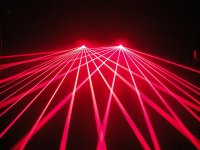Ok, so I know a couple of you have been waiting to see how these heads compare, so in the interest of fulfilling demand for pics AND vids, here are some pics and vids...
The camera captures the colours poorly, its much more purple than in real life, in fact I was hard pressed to spot the difference in wavelength. However, it does do justice to the brightness perception, again I was hard pressed to tell.
See what you think....
I did take some shots and vids with the greens on as well, however it looks as if my older 532 is somewhat down on power compared to the new one, which I need to investigate. It only has about 30hrs on it and was doing just over 400mW when I got it. The difference in brightness is as noticeable in real life as in the vid, and if you've been paying attention it gives away which is the 650nm out of the 2. So, I've posted those pics/vids over on my RGY build thread so as not to spoil it if you want to have a guess here.''





